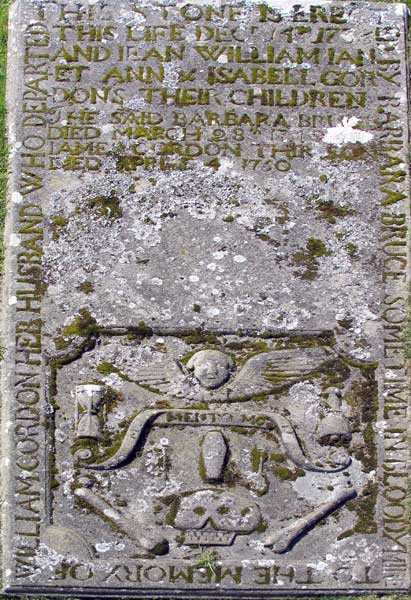Location
On the promontory to the West of Gardenstown the final part of the access road can only be negotiated on foot.
Gardenstown, Macduff
OS Map Reference
NJ 791 644
Description
A typical early 18th cent grave slab with momenti mori, there are so many of these we stop noticing them but they are in their way not only remarkable works of art but also if legible historic records that tell poignant tales of the lives of our ancestors.
The inscription reads: "This stone is here set by Barbara Bruce sometime in Bloodymire to the memory of William Gordon her husband who departed this life Dec 14th 173(8?) and Jean William Janet Ann & Isbeel Gordons their children The said Barbara Bruce died March 28th 174* James Gordon thr son died April 4 17(5?)0
Related Information
The ruined church of St Johns; the ruins of former parish church dedicated to St John the Evangelist said to be founded in 11thC. The present church has been built in two periods at least, the east end probably early 16thC and the rest 17thC; measures 28.75m long by 4.72m wide; rubble built, gable ends; wall and gable remain to roof height; ambry in E wall; 16thC Barclay of Tolly monument; 17thC onwards monuments in churchyard; fell in to ruin mid 19thC when new parish church built in 1830. Repointed in 1961.
In 1004 after a battle with the Danes the battle of the Bloody Pits (or pots) trophy skulls were brought here where they remained till fairly recently in a niche in the wall, Bloodymire (NJ 726 635) where Barbara Bruce lived is a possible site for the battle. One of the skulls went to the Banff museum. Arial photos of Bloodymire farm show crop marks of pits.
Era
1700s
Information Source
Http://www.aberdeenshire.gov.uk/archaeology/smr/ RCAHMS
Related Artefacts
Categories
Iconography
- human face or head
- memento mori
Photographer
- David Watson Hood
Unavailable Data
- Date
- Creator
- External Links
This content was submitted by external contributors and does not necessarily reflect the views of the University of Aberdeen.

